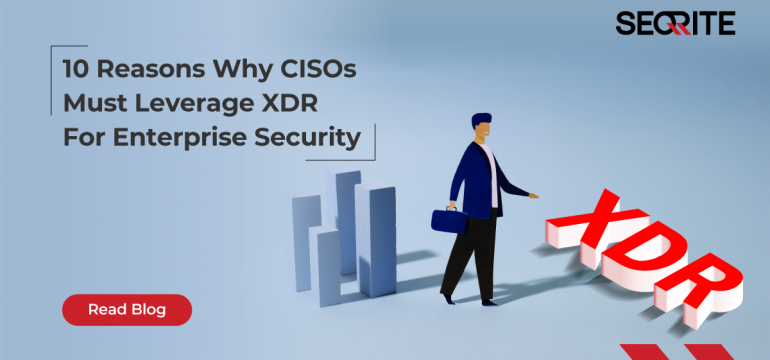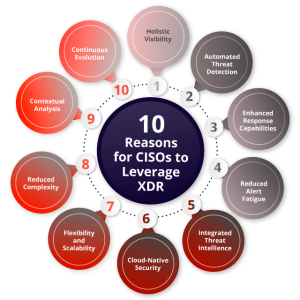10 Reasons Why CISOs Must Leverage XDR For Enterprise Security
Today enterprises face an ever-growing array of sophisticated threats that demand a comprehensive and proactive defense strategy. In the face of these growing cyber threats, CISOs are overwhelmed with managing numerous technologies, often leading to siloed capabilities and platform management challenges. This complexity, compounded by the need for various point solutions and securing board approval for funding, results in a tech stack where many tools don’t communicate effectively. To enhance speed and efficiency, a shift towards XDR (eXtended Detection and Response) is essential. XDR offers a roadmap to streamline operations, integrate tools, and automate responses, ultimately providing a cohesive and effective cybersecurity strategy.
Here are 10 reasons why CISOs need to adopt XDR (Extended Detection and Response) for enterprise cybersecurity.
1. Holistic Visibility
Traditional security measures often operate in silos, leaving critical gaps in visibility. Extended Detection and Response solution, on the other hand, takes a holistic approach by aggregating data from endpoints, networks, servers, and cloud resources, providing a panoramic view of the IT environment. This interconnected perspective enables security teams to uncover subtle anomalies that may have gone unnoticed when examined in isolation, revealing the potential for coordinated attacks.
2. Automated Threat Detection
Speed is of the essence in cybersecurity, and Extended Detection and Response’s automated detection capabilities ensure that threats are identified almost immediately, minimizing the potential for damage. For instance, the rapid encryption of an entire network by ransomware can be swiftly halted by Extended Detection and Response’s ability to instantly detect unusual file activities, allowing security teams to respond with agility.
3. Enhanced Response Capabilities
Once a threat is detected, Extended Detection and Response solutions integrate automated response tools, from isolating compromised systems to revoking unauthorized access. This rapid and efficient response can be a game-changer, as seen in the case of a breached user account conducting unauthorized transactions – Extended Detection and Response solution can automatically revoke the account’s permissions and alert the security team, preventing further damage.
4. Reduced Alert Fatigue
Security professionals are often overwhelmed by the sheer volume of alerts, many of which are false positives. Extended Detection and Response’s intelligent systems, however, prioritize genuine threats, curating a focused list of actual issues for the security team to address. This not only improves efficiency but also enhances the overall security posture by ensuring that resources are directed towards the most pressing concerns.
5. Integrated Threat Intelligence
Cyber threats evolve at a breakneck pace, and XDR platforms provide real-time updates about global cyber threats, ensuring that an organization’s defenses are always current. This proactive approach can be particularly beneficial when a new malware variant emerges overseas, as the XDR system can be quickly updated to defend against it before it even reaches the enterprise’s region.
6. Cloud-Native Security
As cloud adoption continues to rise, so do cloud-specific threats. Extended Detection and Response solution ensures that cloud environments, often the backbone of modern businesses, are not left vulnerable. This is especially crucial in the wake of incidents caused by a misconfigured firewall in a cloud environment – a scenario that could potentially be averted with robust XDR coverage.
7. Flexibility and Scalability
Modern enterprises require security solutions that can seamlessly adapt to their changing scales and operations. XDR platforms are designed to handle this growth, ensuring that a startup’s transition into a multinational corporation can be secured without the need for a complete security overhaul.
8. Reduced Complexity
Managing disparate security tools can be a logistical nightmare, but XDR amalgamates multiple functionalities into a unified dashboard, streamlining security operations. Instead of coordinating between different vendors for endpoint protection, network security, and cloud security, enterprises can now manage their defenses from a single, coherent platform.
9. Contextual Analysis
XDR doesn’t just provide data; it offers insights. By piecing together information from various sources, Extended Detection and Response solution can provide a comprehensive narrative of a security event. For instance, if a user accesses sensitive data late at night, XDR can correlate this with unusual server communications and data transfers, painting a clearer picture of a potential data breach.
10. Continuous Evolution
Cyber adversaries are relentless in their pursuit of new vulnerabilities, and XDR solutions are designed to keep pace. The best XDR platforms learn and adapt from each security event, ensuring that their algorithms and defenses are constantly evolving to stay ahead of the curve. This adaptive intelligence can be particularly valuable in the aftermath of a sophisticated phishing scheme, as the XDR system updates its algorithms to provide even stronger protection against similar future threats.





